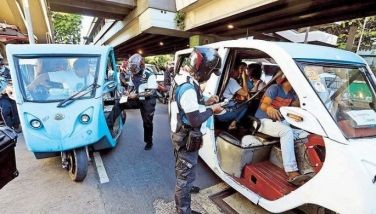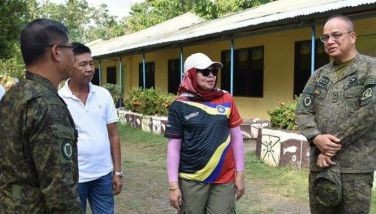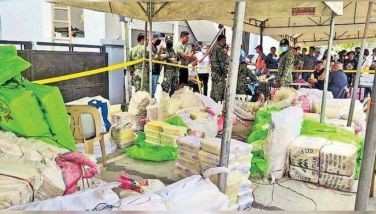Hataman: Good governance boosts ARMM economy
COTABATO CITY, Philippines - The conflicts in some isolated areas in the Autonomous Region in Muslim Mindanao (ARMM) the past two years did not prevent the area's economy from achieving a 3.6 percent growth in 2013, from a negative 3 percent in 2010. .
ARMM Gov. Mujiv Hataman told reporters here Friday the Philippine Statistics Authority (PSA) recorded a 1.1 percent growth of the region’s economy in 2012, and, subsequently, a considerable 3.6 percent rise in 2013.
“That's something we are so happy about. This economic growth is a result of good governance and the initial dividends of the Mindanao peace process,” Hataman said.
Hataman first assumed as appointed caretaker of ARMM in Dec. 22, 2011 and was elected regional governor during the area’s May 13, 2013 elections.
He said the data released this week by the PSA stated that the total value of commercial goods and services produced by ARMM in 2013 peaked at 3.6 percent, from the measly 1.1, and a negative 3 percent mark in 2012, and in 2010, respectively.
The PSA data also indicated that agriculture, such as yellow corn farming, fishing, and forestry accounted for 61.3 percent of ARMM’s improving economy, along with services, at 33.6 percent, and industries, at 5.1 percent.
Hataman said it was also for the cooperation of the five provincial governors in the autonomous region and their constituent-mayors with the ARMM's "reform agenda," meant to improve the regional bureaucracy and the local business climate, that the region's economy improved considerably in the past two years.
Hataman said he is confident the region’s economy will have a good standing in 2014, owing to the continuing influx of foreign capitalists now putting up viable Cavendish banana and oil palm projects in the ARMM’s neighboring Maguindanao and Lanao del Sur provinces.
The region also covers the island provinces of Basilan, Sulu and Tawi-Tawi, known for having vast marine fishing spots. Basilan is the region's top producer of exportable processed rubber bales from rubber tree farms scattered in the island province. Tawi-Tawi and Sulu are both producers of carageenan seaweeds, in big volumes, that are also being exported abroad by local merchants.
Among the latest multi-billion agricultural ventures by foreign investors in the province is the 1,500-hectare "all organic" banana plantation near the site of the infamous November 23, 2009 "Maguindanao Massacre" in Barangay Masalay in Ampatuan town in the second district of Maguindanao.
The large-scale banana farming project, which will initially employ 2,500 Moro workers, was launched on July 30 by its foreign benefactors, local officials, and representatives of the military, led by Maguindanao Gov. Esmael Mangudadatu and the ARMM Regional Agriculture Secretary Makmod Mending Jr.
The PSA's latest report on the ARMM's economy showed that the region’s agriculture and fishery sectors bounced back in 2013, from the retrogression caused by armed conflicts and calamities in years past.
Citing latest PSA data, the ARMM’s Bureau of Public Information (BPI), in an emailed press communiqué, said the region’s continuing “financial mediation” also grew from 10.7 percent to 18.5 percent in 2013, while trade and repair services expanded from 4.0 percent to 5.7 percent in the same year. Public administration and defense also grew from 5.5 percent in 2012 to 5.9 percent in 2013, the BPI-ARMM said.
The BPI-ARMM said there were also accelerated expansions in commercial mining and quarrying activities in the region in recent months.The construction boom in the five ARMM provinces also generated employment for about a thousand skilled workers, the bureau said.
The construction and engineering fields also improved from a “negative” 3.1 percent in 2012, to 1.2 percent in 2013, the BPI-ARMM said.
“The executive department of the autonomous region is thankful to Malacanang for maximizing its socio-economic interventions intended to improve the region’s economy and promote normalcy in the ARMM’s conflict-stricken areas,” the BPI-ARMM said.
The ARMM’s Regional Board of Investments had earlier announced that capital inputs poured by foreign and local capitalists into the autonomous region from January to July 2014 was 72 percent higher than that of the same period in 2013.
Hataman said part of the credit, for the feat, has to go to the regional public works department for having either constructed new, or rehabilitated a total of 524.4 kilometers of old road networks in the autonomous region from 2012 to 2013.
“These roads helped improved the region’s economy,” Hataman said.
He said the office of Regional Public Works Secretary Engineer Hadji Emil Sadain had also constructed recently two seaports in Sulu, and is presently rehabilitating a centuries-old Chinese boat dock in Bongao, capital of Tawi-Tawi, which is a major trading port in the province.
- Latest
- Trending



























